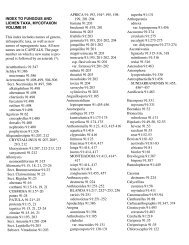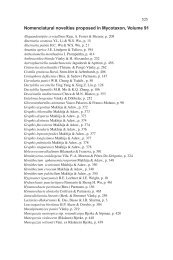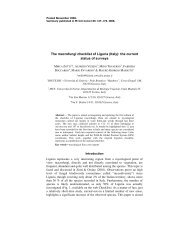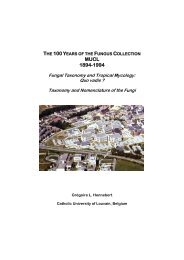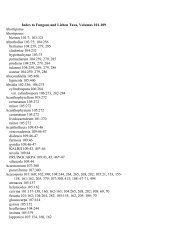download full review [pdf] - Mycotaxon
download full review [pdf] - Mycotaxon
download full review [pdf] - Mycotaxon
You also want an ePaper? Increase the reach of your titles
YUMPU automatically turns print PDFs into web optimized ePapers that Google loves.
548 ... Hawksworth, Editor<br />
In the body of the work, 954 pages treat the genera and species in sequence<br />
(except in Cladonia). The treatments are mainly based on the first edition,<br />
but with additional generic authors added to the byline, newly incorporated<br />
genera and species are to be expected. Hard revision has been undertaken, with<br />
special care taken with critical taxonomic groups. A new generic segregation<br />
in Parmeliaceae is adopted following Hawksworth et al. (2008). Thanks to the<br />
editors (particularly “Tony” Fletcher and Brian Coppins), most of the genera<br />
not treated critically and <strong>full</strong>y in detail in the first edition are now intensively<br />
revised and more comprehensive (e.g. Aspicilia, Caloplaca, Lecania, Lecanora,<br />
Lecidea; but see the interesting and critical <strong>review</strong> by Fletcher 1994). The main<br />
work finishes with two added species in an appendix, 42 pages of references<br />
in alphabetic sequence, and an index with the epithets of the mentioned taxa.<br />
There are 49 line drawings, five more than in the first edition; these improve<br />
the flora and illustrate the glossary and critical characters in the case of difficult<br />
species in various genera, but some are poorly scanned or copied.<br />
However, the inevitably commented on small things do not detract from<br />
the main achievement of this book, a landmark comprehensive updating<br />
compilation for the identification of lichens, not only from Britain and Ireland,<br />
but from temperate and oceanic areas in Europe. The book definitely enhances<br />
the reputation of the BLS and of the contributors. I use my copy almost every<br />
day.<br />
Barrasa JM & Rico VJ (2001) Lichenized species of Omphalina (Tricholomataceae) in the<br />
Iberian Peninsula. Lichenologist 33: 371-386.<br />
Fletcher A (1994) Book Reviews: The lichen flora of Great Britain and Ireland. Edited by O.W.<br />
Purvis, B.J. Coppins, D.L. Hawskworth, P.W. James & D.M. Moore. London: Natural History<br />
Museum Publications with the British Lichen Society. 1992. Lichenologist 26: 217-220.<br />
Fletcher A (2008) Taxonomist – An endangered species. British Lichen Society Bulletin<br />
103: 2-6.<br />
Galloway DJ (2007) Flora of New Zealand: Lichens, including lichen-forming and<br />
lichenicolous fungi. 2 nd edn. 2 vols. Manaaki Whenua Press, Lincoln, New Zealand.<br />
Hawksworth DL, Blanco O, Divakar PK & Crespo A (2008) A first checklist of parmelioid<br />
and similar lichens in Europe and some adjacent territories, adopting revised generic<br />
circumscriptions and with indications of species distributions. Lichenologist 40: 1-21.<br />
Hitch C[JB] (2009) New, rare and interesting lichens. British Lichen Society Bulletin 104:<br />
42-52.<br />
Kirk PM, Cannon PF, Minter DW & Stalpers JA (eds) (2008) Ainsworth & Bisby’s dictionary<br />
of the fungi. 10 th edn. CAB International, Wallingford.<br />
Lumbsch HT & Huhndorf SM (eds) (2007) Outline of Ascomycota – 2007. Myconet 13: 1 – 58<br />
[http://www.fieldmuseum.org/myconet/outline.asp].<br />
Purvis OW, Coppins BJ, Hawksworth DL, James PW & Moore DM (eds) (1992) The lichen<br />
flora of Great Britain and Ireland. Natural History Museum Publications, London.<br />
Víctor J. Rico<br />
Departamento de Biología Vegetal II, Facultad de Farmacia, Universidad Complutense<br />
28040 Madrid, Spain


![download full review [pdf] - Mycotaxon](https://img.yumpu.com/5381692/40/500x640/download-full-review-pdf-mycotaxon.jpg)
